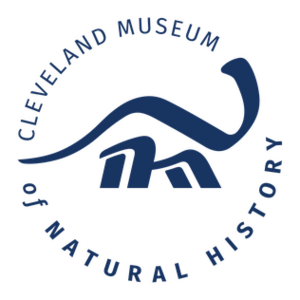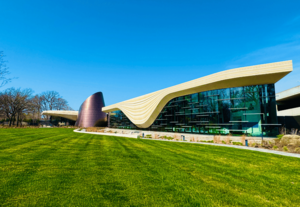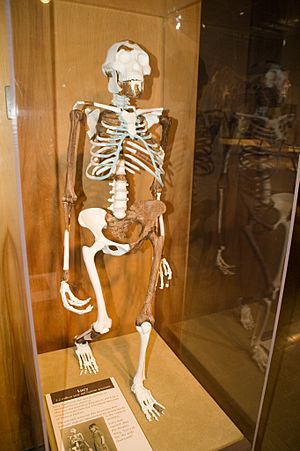Cleveland Museum of Natural History facts for kids
 |
|

Exterior of the Cleveland Museum of Natural History in Spring 2025
|
|
| Established | 1920 |
|---|---|
| Location | 1 Wade Oval Drive Cleveland, Ohio 44106 U.S. |
| Visitors | 260,000 |
The Cleveland Museum of Natural History is an exciting natural history museum located in University Circle, a special area in Cleveland, Ohio. It's about five miles east of downtown Cleveland. The museum was started in 1920 by Cyrus S. Eaton. Its main purpose is to do research, teach people, and build collections in many fields. These fields include anthropology (the study of humans), archaeology (ancient cultures), astronomy (space), botany (plants), geology (Earth's rocks), paleontology (fossils), and the study of animals.
The museum's history goes back to 1836. That's when a collection called "the Ark" was formed by William Case in Cleveland. Later, the Kirtland Society of Natural History was founded in 1869. The museum today continues the work of these early groups.
A famous discovery linked to the museum is "Lucy." Donald Johanson was a curator at the museum when he found Lucy's skeletal remains. Lucy is an ancient human ancestor called Australopithecus afarensis. Today, experts like Nicole Burt, Emma Finestone, and Elizabeth Sawchuk continue to study human origins at the museum.
The museum has recently completed a huge renovation and expansion project. This big update cost $150 million. The museum started building new areas in June 2021. The main renovation was finished in December 2024.
Contents
History
Early Beginnings
The Cleveland Museum of Natural History has a long history. It began partly in the 1830s. There was a small building called the Ark on Public Square. It held a collection of stuffed animals, from birds to mammals. This collection belonged to Leonard Case Sr. He passed it on to his sons, Leonard Case Jr. and William Case.
A group of 26 men, called Arkites, often visited the Ark. They collected, researched, and talked about their discoveries. At that time, Cleveland did not have any museums. In 1876, the Ark's collection moved to Case Hall. The original Ark building was torn down. The collection stayed in Case Hall until 1916. Then, the building became the Cleveland Public Library.
The Cleveland Museum of Natural History, as we know it, started in 1920. It was first in an office building. By the end of 1921, the museum moved to a large house on Euclid Avenue. This area was known as "millionaires' row." The museum opened to the public at this new spot on June 24, 1922.
Big Discoveries and Growth
The museum received a valuable collection of precious stones in 1926. This was from Jeptha Wade II. In 1930, the museum went on a bird-watching trip to Kenya. This helped them add to the Case collection.
A huge dinosaur, Haplocanthosaurus, was found by museum staff in 1954. This 70-foot-long plant-eating dinosaur is one of the most complete ever found. The museum also helped run the Cleveland Zoo from 1940 to 1975. It also helped create the Cleveland Aquarium. The museum managed the aquarium until 1985. By 1995, the museum also looked after 12 natural areas nearby. These areas were protected as wildlife sanctuaries.
Moving to University Circle
In 1958, the museum moved to its current home in University Circle. This new building had exhibits and spaces for learning. The museum quickly added more sections. These included an observatory, a planetarium, and the Kirtland Hall of Nature.
The Ralph Mueller Observatory opened in December 1960. It has a 10½-inch telescope. This telescope was built in 1899. It was first used at Western Reserve College. The museum got it 61 years later.
In 1972, the museum grew even more with an 85,000-square-foot addition. This added more galleries, an auditorium, a library, classrooms, and a paleontology lab. It also created the main entrance and lobby. This made the museum a circular building with a courtyard in the middle.
In 1973, curator Donald Johanson made a huge discovery in Ethiopia. He found "Lucy," a very important fossil. Lucy showed that early human ancestors could walk upright. She was a female hominin who lived 3.2 million years ago.
A new 62,000-square-foot wing was finished in 1989. This wing added a large hall for special exhibits. It also included a bigger gift shop. Three floors were added for collections and offices.
Modern Updates
The Shafran Planetarium opened in January 2002. Its outside design helps visitors find Polaris, the North Star, at night. The building's outer covering sparkles with tiny lights. These lights look like stars but don't cause light pollution.
The museum started a big renovation project in June 2019. This project is called the Centennial Transformation Project. A groundbreaking ceremony happened on June 24, 2021. The new design is inspired by melting ice and water. The project expanded the museum's total space to 375,000 square feet.
New parts of the museum opened in December 2022. A new visitor hall opened in October 2023. Two major new halls, Dynamic Earth and Evolving Life, opened on December 13–15, 2024. This was two years earlier than planned!
Collections

The museum has millions of items in its collections. These include fossils, animal specimens, archaeological finds, minerals, and more.
Some of the most important items you can see are:
- Many Late Devonian fossil fish from the Cleveland Shale. These include skulls of the armored fish Dunkleosteus. Many are now on display.
- A large collection of 900 monkey and ape skeletons. There are also over 3,100 human skeletons (the Hamann-Todd Collection).
- The skull of a young tyrannosaur. This skull was once thought to be a different species, Nanotyrannus lancensis.
- The Haplocanthosaurus dinosaur skeleton, nicknamed "Happy." It is now on display in the museum's Visitor Hall.
- The most complete skeleton of a Coelophysis bauri. This dinosaur is made from several adult skeletons found in New Mexico. You can see it in the Evolving Life Wing.
- The mounted remains of Balto the sled dog. Balto is on display in the museum's Visitor Hall.
- A large mineral collection. This includes a Moon rock and the Jeptha Wade gem collection. Part of this collection is in the Visitor Hall.
- Replica skeletons of Triceratops and an adult Tyrannosaurus. Also, "Jane," a young tyrannosaur, is on display in the Dynamic Earth Wing. Jane is also displayed at the Cleveland Hopkins International Airport.
- A mammoth skeleton is in the Evolving Life Wing. The museum has many mastodon and mammoth specimens.
- A cast and a lifelike model of "Lucy," the Australopithecus afarensis skeleton.
- A partial Allosaurus skeleton is in the Evolving Life Wing.
- A collection of 30,000 plant fossils.
- A Foucault pendulum in the Dynamic Earth Wing. This pendulum shows the Earth's rotation. A time capsule was buried under it in 1996 and will be opened in 2046.
The museum has also made many new discoveries. For example, a new horned dinosaur, Albertaceratops nesmoi, was named in 2007 by a former museum curator.
Hamann-Todd Collection
The Hamann-Todd Collection is a special group of more than 3,100 human skeletons and over 900 primate skeletons. This collection started in 1893. It was first kept at Western Reserve University Medical School. Later, it was moved to the Cleveland Museum of Natural History.
Carl August Hamann started the collection in 1893. T. Wingate Todd took over in 1912. Todd collected most of the human skeletons, over 3,000, before he passed away in 1938. This collection is very important for studying human and primate anatomy.
Perkins Wildlife Center
The Ralph Perkins II Wildlife Center and Woods Garden opened on September 3, 2016. This area features live animals and plants that are native to Ohio. It's a great place to see local wildlife up close.
Artwork
The museum also has a cool collection of art:
- Steggie is an 18-foot-long, 8-foot-tall Stegosaurus sculpture. It has welcomed museum visitors since 1968. The original sculpture was replaced with a new one, Steggie II, in 2016. It was painted with colors that match what scientists now believe dinosaurs looked like.
- Victor Schreckengost's Pachyderms reliefs are on a wall outside the museum. These huge 32-ton clay artworks show adult and baby mastodons and mammoths. They were first made in 1955 for the elephant house at the Cleveland Metroparks Zoo. When that building was torn down, the artworks were moved to the museum in 2016.
- Old Grizzly is a four-ton limestone bear sculpture. William McVey created it in 1934. It used to be near the bear area when the Cleveland Zoo was in Wade Park. Now, it sits in the Perkins Wildlife Center.
- A large collection of prints, including full first-edition sets of Audubon’s Birds of America.
- Original bird illustrations by Roger Tory Peterson.
- Stone prints by modern Inuit artists.
- Original watercolors by Henry Wood Elliott. These show his travels in Alaska and his observations of fur seals.
- The Hexter Collection of Astronomical and Navigational Objects. This includes sundials, compasses, and other tools used to study the sky. They were made by European and Persian artists between the 15th and 19th centuries.
- Original large paintings by Jay Matternes. These show geology, paleontology, and biology topics.
- Fossil models created by early 20th-century sculptors.
- Original wax plant models and fossil dioramas from the Marchand Studio.
- Original biome dioramas from the Paul Jonas Studio.



